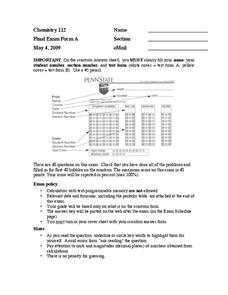Curated OER
Sub-Atomic Particles and Energy
In this atomic particles worksheet, students complete an elements chart comparing atomic number, mass number, protons, neutrons, and electrons. Students write the electron configuration for atoms. This worksheet has 1 graphic organizer...
Curated OER
Elements
In this elements activity, students give the electron configuration for given atoms or ions. This activity has 4 fill in the blank questions.
Curated OER
Chemistry 151 - Final Review
In this chemistry review worksheet, students give atomic symbols for given atoms, calculate moles, determine empirical formulas, and balance chemical equations. This worksheet has 1 drawing, 9 fill in the blank, and 12 word problems.
Curated OER
Elements and Molecules
In this elements worksheet, students write the electron configuration, structural formula, or Lewis electron dot structure of given elements and compounds. This worksheet has 8 fill in the blank and 3 drawings.
Curated OER
Code Makers - Electron Configuration, Aufbau Principle
Students write the electron configuration of elements using the Aufbau principle. For this chemistry lesson, students build their own key that demonstrates the principle.
Curated OER
Electrons and Atoms
In this atoms worksheet, students determine the velocity, wavelength, power, and frequency of given atoms. Student describe wave-particle duality and give the principle and angular quantum numbers for given orbitals. This worksheet has...
Curated OER
Chemistry 112: Form A-
In this chemistry 112 worksheet, students use their knowledge of chemistry concepts to answer the multiple choice questions provided. Students calculate the answers using the appropriate formulas.
Curated OER
Periodic Table & Its Trends
Learners review atomic structure and then participate in a activity in which they categorize several "elements" into some form of order based on their properties. They discuss the trends they see. They also practice several electron...
Curated OER
Swinging Electrons
Students illustrate paramagnetic and diamagnetic differences due to the unfilled and filled valence shells. They prepare saturated solutions and place into test tubes.










